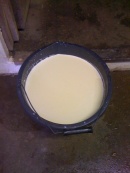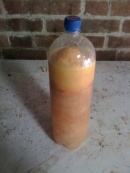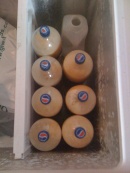Fallo en la Transferencia Pasiva de Inmunidad
Also known as: FPT
Introduction
Transfer of passive immunity in the bovine neonate occurs solely through maternal colostrum. This is in contrast to humans where placental transfer of immunity via specific Fc receptors is the predominant mechanism. However, inadequate transfer of immunity is a relatively commonly diagnosed problem affecting young stock. This is particularly the case in modern Holstein dairy herds, where large milk yields dilute the antibody concentration in the colostrum meaning relatively more must be consumed to have the same immunity transferred. Due to the lower yields and possibly other genetic reasons, this tends to be less of a problem in suckler herds.
Receiving sufficient colostrum and having adequate immunity is important to reduce the risk of pre and post weaning morbidity and mortality. Good calf health is fundamental to achieving adequate weight gains and reaching the optimal age at first calving.
Inadequate absorption of immunoglobulin occurs because:
- The neonate did not receive any colostrum.
- The neonate did not receive enough colostrum.
- The neonate did not absorb enough colostrum.
- The quality of the colostrum was inadequate.
Colostrum quality (amount of IgG) depends on:
- Breed - antibody and milk fat are correlated, thus Jersey cows have the highest amount of immunoglobulin. Conversely, Holsteins have the lowest amount of immunoglobulin.
- Nutrition - it is especially important for cows during the dry period (last 2 months of pregnancy) to have the correct nutrition in order to produce immunoglobulin. There is also some evidence that trace element deficiencies during the dry period may affect colostrum quality.
- Season - the lowest quality of colostrum is produced in the late winter months as this is correlated to the quality of forage available. High ambient temperatures may also have an adverse effect which is likely to be related to depressed dry matter intakes. In countries where this is a problem, heat abatement systems may help.
- Stress - dams under increased stress produce colostrum of reduced quality.
- Immunostatus of the dam - dams exposed to specific diseases mount an immune response and produce antibodies for that particular disease. These antibodies are then transferred to the neonate via colostrum. Dams may also be vaccinated which, if done during the colostrum production period (last 2 months of gestation), will also provide the neonate with some protection via passive transfer.
- Milk yield - increased yield dilutes the amount of immunoglobulins in the colostrum. The volume of colostrum produced at the first milking may be used as a guide of colostrum quality.
- Dry Period Length - excessively short dry periods, no dry period or mistakenly milking a cow during the dry period will have detrimental effects on colostrum quality.
- Dripping from teats - poor teat confirmation may result in a poor teat seal and thus dripping before the calf has been born or sucked.
- Parity - older cows have better quality colostrum as they have been exposed to more pathogens and may have had multiple vaccinations causing their colostrum to have a higher amount of immunoglobulin.
- Mastitis - A cow with clinical mastitis, or indeed any other illness, should not be used as source of colostrum.
- Pooling - Cow’s colostrum may be pooled to ease the calf management period. However, the larger volumes of lower quality colostrum tend to be relatively over-represented meaning this can be to the detriment of colostrum quality. Therefore this practice is to be discouraged. It is also a risk for the spread of Johnes disease.
- Time of collection - The highest quality colostrum will be collected from the dam when milked within 1-2 hours of calving.
Colostrum quantity depends on:
- Amount the neonate suckles - a strong neonate and good mothering from the dam increases the amount the neonate suckles. Udder conformation also influences the accessibility of the teats to the neonate. Dystocia may reduce mothering and produce a weak calf that potentially causes an increased time to the first suck and/or reducing the amount the neonate consumes.
- Premature births - if born early the dam has a shorter period of time for concentration of antibodies from the blood to the colostrum. It is more likely that the neonate will also be weaker and smaller, causing the amount of colostrum sucked to be reduced.
Failure of absorption from the intestines:
The amount of colostrum recommended is a minimum of 3 liters within 6 hours of birth. This equates to 8-10% of the neonates body weight. If the colostrum is of sufficient quality, this should provide approximately 100-200g of IgG in the first feed. Timing is important and is considered optimal within the first four hours before progressively declining towards what is referred to as “gut closure”. The timing of the first feed can influence when this occurs and a delay can prolong the time before gut closure to approximately 36 hours. Therefore the first feed is the most important in the uptake of colostrum derived passive immunity.
Diagnosis
Failure of passive transfer can be a problem in the individual calf but more importantly can be a herd level problem which requires investigation. Diagnosing the problem can be done in a variety of ways each with their advantages and disadvantages. In all cases, calves should be sampled no earlier than 24 hours of age and up to a maximum of 7 days when the calf’s own endogenously produced antibodies can distort the results.
For more detail see Colostrum Quality Testing
Prevention
After diagnosis, herd level prevention strategies should be based around the following areas:-
1. Method and amount of colostrum administration
On a modern Holstein herd, leaving the calf to suckle from its dam is often inadequate to transfer sufficient passive immunity. Therefore, this process may be assisted by using a bottle or using a stomach tube. Farmers may need to be trained with the latter approach which is often preferred as it is more time efficient.
2. Identification of high risk cows and calves
From the risk factors for FPT stated above, at risk calves can be identified and action taken to ensure adequate colostrum intake.
3. Colostrum storage
It is often useful for the farmer to store colostrum in the freezer for use when needed. Anecdotally, storage has been reported as satisfactory for up to 12 months. However, repeat freeze thawing should be minimized as this can have adverse effects on colostrum quality. Microwaving the colostrum as part of the thaw is not recommended due to protein denaturing. Thawing should therefore be done slowly by putting the bottles into warm water.
On harvesting, the colostrum should not be maintained at room temperature for prolonged periods due to bacterial growth occurring which may harbour infectious agents. Bacterial contamination can be minimized by good udder preparation prior to milking and using clean equipment. Freezing should be performed as soon as possible after collection. If the colostrum is not going to be frozen but kept for later use, it should be refrigerated and used within a few days.
It is important to select the dam carefully when deciding which colostrum to store. The cow should be healthy and in good condition. It is advisable to check the colostrum with a colostrometer before storage to try to ensure adequate quality. In herds with a history of Johnes disease, it may be worth testing the cow for infection, although due to the poor sensitivity of the test in clinically normal animals this is not a guarantee of uninfected colostrum.
4. Colostrum quality
This can be done using a colostrometer.
5. Colostrum supplements
A colostrum supplement is added to normal colostrum to try to increase the IgG content. It is important that products of this type are not used as the sole source of colostrum which would confer inadequate immunity to the neonate.
6. Colostrum replacers
Colostrum replacers are designed to completely replace the need for normal colostrum from the dam. The advantages of these products are convenience and allowing some immunity to be conveyed to the calf when natural colostrum is not available. Their disadvantages are the cost and the lack of specific immunity to the pathogens present on the farm. They may be useful on particular farms affected with Johnes disease.
In situations where despite colostrum management practices being optimized, there is still evidence of FPT or high calf morbidity and mortality, other measures that may be more targeted to individual diseases may be more appropriate.
Literature Search
Use these links to find recent scientific publications via CAB Abstracts (log in required unless accessing from a subscribing organisation).
Colostral immunity in newborn calf: methods for improvement of immunoglobulins absorption. Zarcula, S.; Cernescu, H.; Knop, R.; Facultatea de Medicină Veterinară, Timişoara, Romania, Lucrari Stiintifice - Universitatea de Stiinte Agricole a Banatului Timisoara, Medicina Veterinara, 2008, 41, pp 195-202, 31 ref. - Full Text Article
References
McGuirk, S.M., Collins, M. (2004). Managing the production, storage, and delivery of colostrum. Veterinary Clinics of North America: Food Animal Practice. 20(3):593-603.
Weaver, D.M., Tyler J.W., VanMetre, D.C., Hostetler, D.E., Barrington, G.M., (2000). Passive transfer of colostral immunoglobulins in calves. Journal of Veterinary Internal Medicine. 14(6):569-77.
A.H. Andrews (2004) Bovine Medicine - Diseases and Husbandry of Cattle (2nd Edition) Blackwell Publishing
Koterba, Drummound and Kosch (1990) Equine Clinical Neonatology Williams and Wilkins
P. Lydyard, A. Whelan and M.W. Fanger (2004) Immunology Garland Science 2nd Edition
www.sheepandgoat.com
| Este artículo ha sido revisado por pares, pero aún no ha sido evaluado por un experto. |



